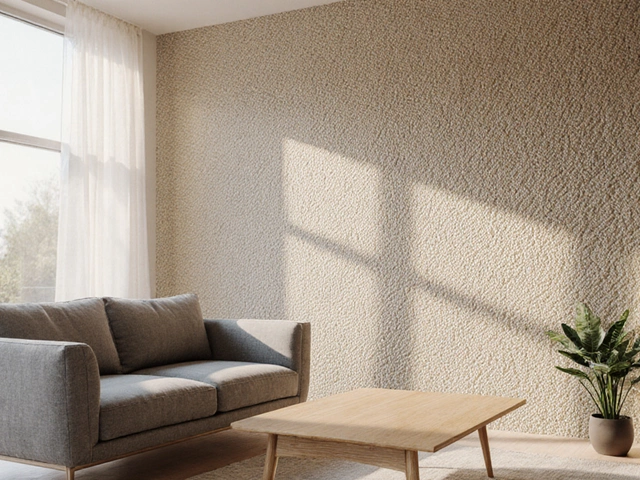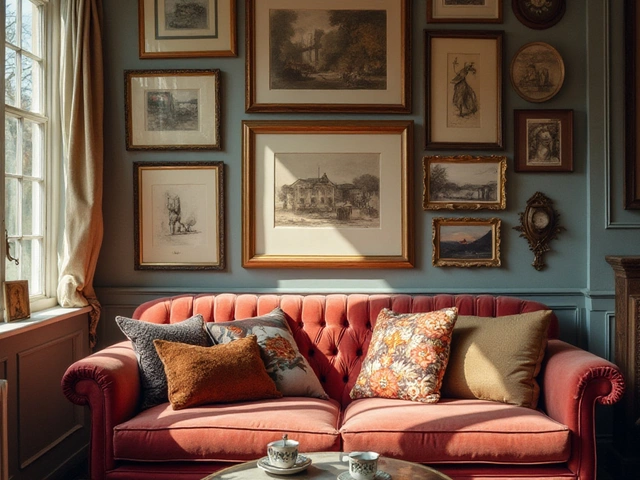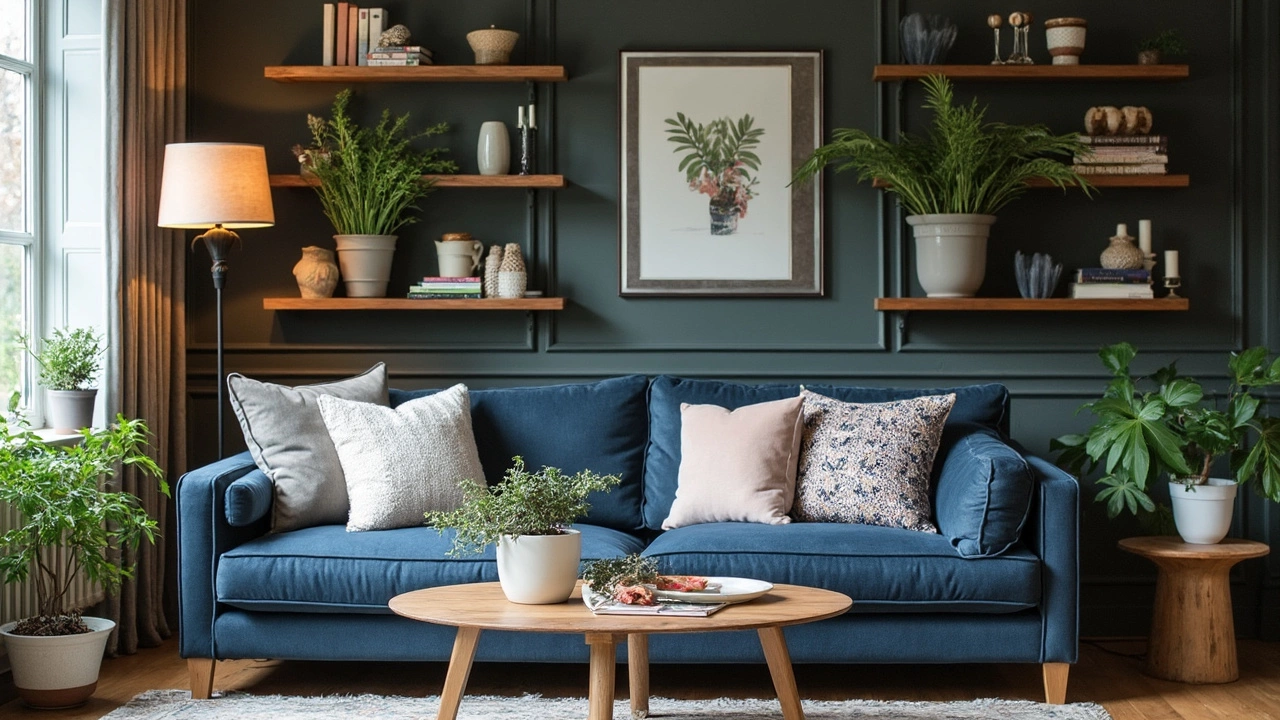
Ever step back from your living room and feel like something’s just…off? You might nail the colors or snag the perfect sofa, but somehow the space doesn’t click. Here’s the trick a lot of designers swear by: the 3-5-7 rule. It’s all about grouping your decor pieces in odd numbers—three, five, or seven items together instead of going even-steven.
This rule works for shelves, your coffee table, or that awkward sideboard you never know what to do with. The next time you want to style a space, count your items: three vases, five candlesticks, seven framed photos. It feels random, but our brains like the look a lot more than evenly matched pairs. Give it a shot on a bookshelf or coffee table—suddenly, your stuff looks more intentional and less like you dumped it there at random.
If you’re tired of your space feeling stiff or too symmetrical, the 3-5-7 rule shakes things up, making the room feel lived-in and cool. It’s one of those quick tweaks that actually make a big difference within minutes. Grab some objects you love and start experimenting—you’ll notice the shift right away.
- Why Odd Numbers Work in Design
- How to Use the 3-5-7 Rule on Shelves and Tables
- Picking and Grouping The Right Items
- Common Mistakes and How to Avoid Them
- Easy Ways to Practice the Rule at Home
Why Odd Numbers Work in Design
Have you ever noticed how decorating with odd numbers just looks better? There’s actually science behind it. Designers use the 3-5-7 rule because the human brain naturally finds odd numbers more interesting. When our eyes scan a room, odd-numbered groups force us to look around, making things feel lively—versus even numbers, which our brains tend to split up or ignore.
Here’s a simple rundown: Three items create a mini story, five add a bit more fun, and seven stops things from getting too cluttered, even if you love showing off your favorite stuff. This habit goes way back. Marketers use the same rule in window displays and ads because people notice things in threes or fives. Restaurants stack food in odd-numbered portions on a plate for the same reason—it’s just more appealing.
- Odd-numbered groups stand out instantly. Our brains can spot them faster and remember them longer.
- They break up the symmetry. Rooms feel relaxed and effortless, rather than like you tried too hard.
- You’re less likely to get that weird, stuffy vibe where everything matches a little too perfectly.
Want some proof? Check out this quick comparison of how rooms feel different based on the number of decor items:
| Number Grouped | Common Effect |
|---|---|
| 2 | Feels formal, sometimes boring |
| 3 | Balanced, relaxed, interesting |
| 4 | Often looks staged or stiff |
| 5 or 7 | Dynamic, stylish, memorable |
Odd-number groups give your living room a boost without adding anything expensive. Most people feel the vibe change immediately—it just feels "right." Next time you’re styling a shelf or table, remember: odd numbers win, every time.
How to Use the 3-5-7 Rule on Shelves and Tables
Let’s break down how to actually put the 3-5-7 rule to work on your shelves and tables. You don’t need fancy decor or brand-new stuff—just pick out what you already love and arrange it in groups of three, five, or seven. Start small if you like, maybe on a coffee table.
The idea is simple: odd groups look better to our eyes than even ones. Three candles on a tray catch attention better than two or four. When you go with five, you get a mix of heights and colors without it feeling too perfect. And seven is a sweet spot for big bookcases or mantels, giving visual interest without going overboard.
Here’s how to do it:
- Pick a variety—Choose items with different shapes, sizes, and textures. Mix hard with soft, tall with short.
- Use a tray—Gather three or five objects on a tray for an instant styled look. It keeps things tidy and pulls the group together.
- Layer your objects—Place taller items at the back, smaller ones up front. You want a little overlap, so it looks collected, not scattered.
- Think of balance—If you’re decorating a long shelf, put your odd-numbered groups off-center for a natural feel.
If you’re still not sure, check how professional stylists actually do it. Here’s a quick table based on a 2023 study from a top interior design magazine looking at what people prefer in living room setups:
| Grouping Style | Perceived Attractiveness | Time Taken to Arrange |
|---|---|---|
| Three Items | 82% called it 'pleasing' | 2 minutes |
| Five Items | 89% called it 'balanced' | 3 minutes |
| Seven Items | 77% called it 'interesting' | 4 minutes |
You really don’t have to overthink it. Grab a set of your favorite books, family photos, or quirky finds from vacation. Cluster them using this rule and step back. The space just feels finished because you followed a proven approach. The real magic? No complicated math or ruler required. Just group and go—it works every time for living room decor that looks intentionally effortless.
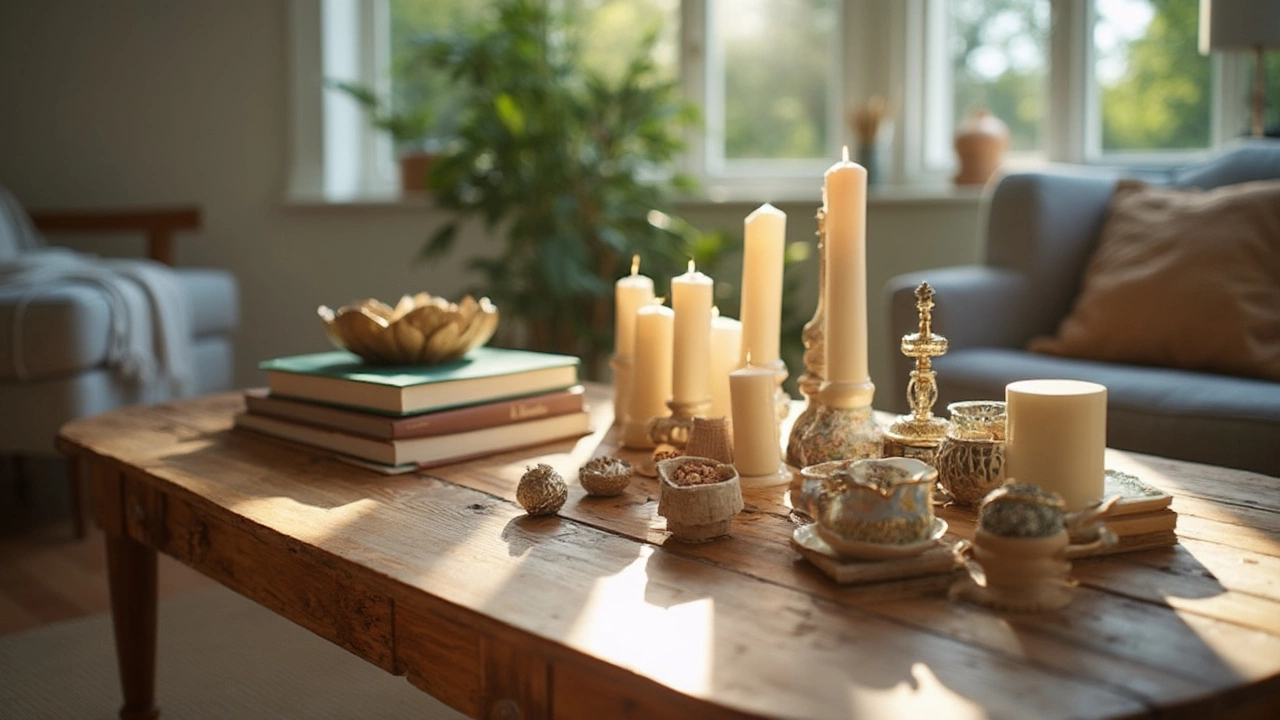
Picking and Grouping The Right Items
Let’s get into the nuts and bolts of the 3-5-7 rule. It’s not just about tossing any three, five, or seven things onto a shelf. You want pieces that work together in a way that looks like you planned it—even if it took you two minutes and a cup of coffee.
The trick with living room decor is mixing things up but keeping a thread that ties your items together. For example, grab three books, a small potted plant, and a candle. They’re different, but if their colors or textures echo each other, the group will look pulled together. An easy shortcut: stick to a color palette or one material, like all wood or all white ceramic. It doesn’t have to look matchy-matchy—just related enough to make sense.
Here’s what most interior stylists do when they group:
- Pick items of different heights—give the eye up-and-down movement.
- Layer textures, like a smooth vase next to a woven basket.
- Keep one "star" piece and surround it with supporting items that are simpler and smaller.
- Balance busy pieces with a few that are more minimal.
It actually helps to arrange everything on the floor first. Slide stuff around, swap things out, and only move them to the shelf or table when the combo feels right. If you want some data: a survey by Houzz found that 61% of people who tried odd-number grouping said their shelves looked better afterward versus an even-number setup. That’s a real win if you ask me.
| Item | How It Adds Interest | Quick Tip |
|---|---|---|
| Books | Cues color or personality | Stack or stand, don’t line up evenly |
| Plants | Adds life and shape | Try different pot sizes |
| Candles | Brings in height and glow | Mix short with tall |
| Frames | Personalizes display | Mix horizontal and vertical |
| Bowls/Baskets | Texture and storage | Go for natural materials |
Don’t overthink it. If Bruno, my dog, walks by and knocks off an item? Sometimes the accidental rearrange actually looks better. Keep it playful and keep swapping things out until it feels like home—not like a store display.
Common Mistakes and How to Avoid Them
Alright, here’s where a lot of folks trip up: using the 3-5-7 rule and ending up with more chaos than style. Odd numbers are your friend, but how you use them matters even more. Let’s get into what usually goes sideways and how to keep things looking sharp and balanced in your living room decor.
The biggest slip-up? Grabbing random stuff without thinking about connections. Grouping three totally unrelated objects won’t cut it, because the eye needs some sort of harmony—think similar colors, shapes, or finishes. Tossing a toy, candle, and remote together just looks messy (and yes, Bruno’s squeaky duck doesn’t count as decor, no matter how much he loves it).
A lot of people also crowd their spaces, thinking if three is good, seven must be better. It’s not. Too much “stuff” makes things look busy. 3-5-7 rule is about odd numbers, but only if your objects actually fit the area. Look at your shelf or table and be honest: can it handle that much without feeling packed?
Another trap? Lining everything up like soldiers. The rule works when you mix heights and textures—it creates visual interest. Using only tall items or all the same material will just feel flat. The goal isn’t uniformity—it’s balance and interest.
According to Emily Henderson, a respected interior stylist, "If something feels off in your arrangement, try removing or swapping a piece instead of adding more. Sometimes less really is more."
You want numbers, not just advice? Here’s a quick comparison table to keep things real when applying the 3-5-7 rule on common surfaces:
| Surface | Ideal Number of Items | Common Mistake | Fix |
|---|---|---|---|
| Shelf | 3 or 5 | Items all same size | Mix heights and shapes |
| Coffee Table | 3 | Overcrowded with stuff | Leave some negative space |
| Sideboard | 5 or 7 | Unrelated objects | Stick to a loose theme or palette |
A few easy fixes if things aren’t working:
- Step back and squint—if your eyes dart everywhere, reduce the number of items or line up the heights better.
- Group by color or material—blues together, wood with wood, glass with glass.
- Balance tall, medium, and short objects so things feel layered, not lopsided.
- Always leave a bit of empty space—it’s what lets the good stuff breathe.
Getting the most out of the 3-5-7 rule is about being intentional. You don’t have to overthink each detail, but give some thought to what you’re putting together and why. Your living room will look better—and you won’t find yourself constantly rearranging in frustration.
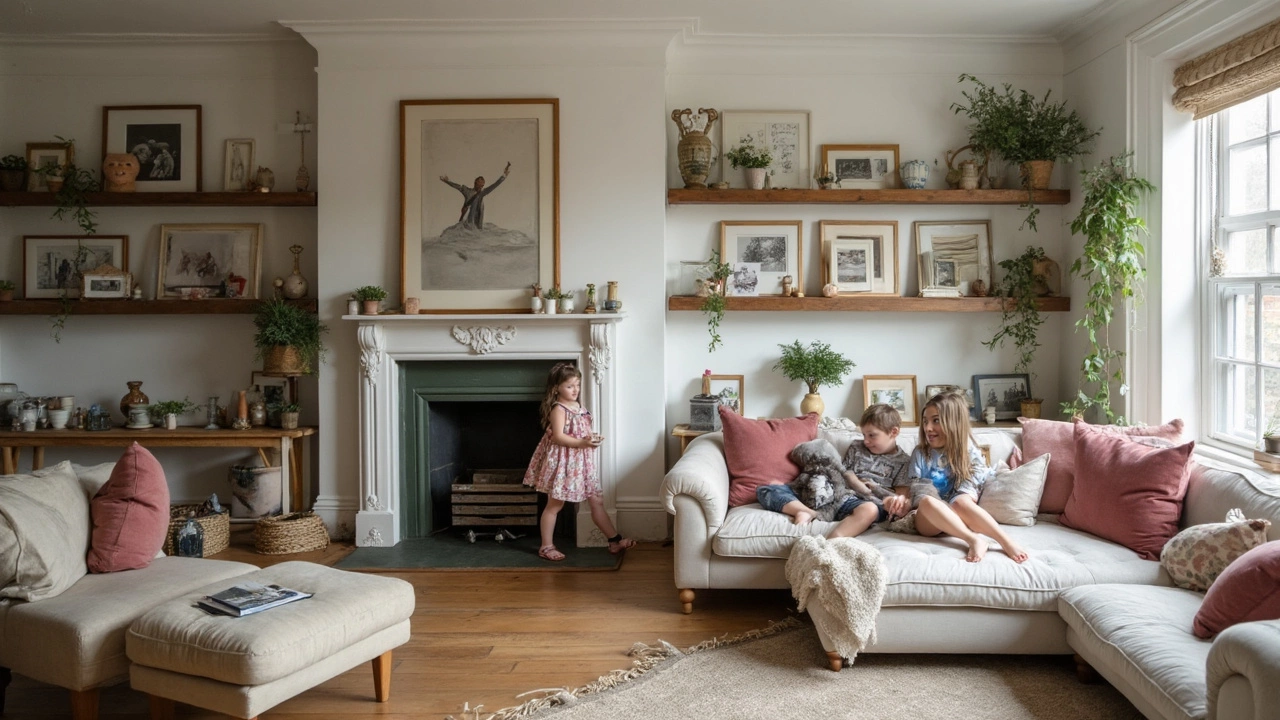
Easy Ways to Practice the Rule at Home
The good news? You don’t need to hire a designer to put the 3-5-7 rule to work in your living room or anywhere else in the house. You can start making changes today with stuff you already own. Let’s break down exactly how you can practice the 3-5-7 rule for decorating, even if your design confidence is zero.
- Pillows on a Sofa: Odd-numbered pillow arrangements always look more relaxed. Try three for a small sofa; go for five if you’ve got a bigger one. Mix up sizes: two big pillows, two smaller ones, and one in a wild pop of color.
- Coffee Table Styling: Place three items—like a tray, a favorite book, and a candle. Or, step it up to five things: a plant, a bowl, a stack of books, a candle, and a small sculpture. The trick is mixing heights and textures so it’s not flat and boring.
- Gallery Wall: Hanging photos or art? Start with a group of three frames in a row, or bump it up to five or seven for a bigger wall. Play around with frame shapes and sizes to keep it interesting.
- Shelf Clusters: When styling shelves, imagine little groupings—three vases (try glass, ceramic, metal), or five travel mementos spaced out in a zigzag line.
- Dining Table Centerpieces: If you’re setting up a centerpiece, group three candleholders or five small pots with succulents, instead of going for a pair of matching candelabras.
Here’s some real data. In a 2024 home survey by Houzz, 74% of people said odd-number groupings made rooms look more ‘effortlessly stylish’ than matched, symmetrical sets. It’s not just about preference; it’s about perception.
| Grouping | Preferred by Survey (%) |
|---|---|
| Odd Number (3/5/7) | 74% |
| Even Number (2/4/6) | 26% |
Don’t overthink it. If you arrange, step back, and something still doesn’t feel right, swap one item for another or change up the order. Decorating is about trial and error as much as it is about any rule, even this one. Bring your personality into it—your souvenirs from a trip, a funny photo of your dog Bruno (who, by the way, loves to knock over vases), or something your kid made at school. If you love it, it works.
